The following is a transcript of the presentation video, edited for clarity.
Point/Counterpoint: There are multiple paths to success.
There is not just one yellow brick road that takes you to social impact, R01s, tenure, pursuit of happiness and lots of stuff. There are lots of different roads of different colors and different difficulties. So the idea is this: What can we say about what those pathways are, and what are some guidelines that might be useful to you as you consider your own pathway?
Considerations
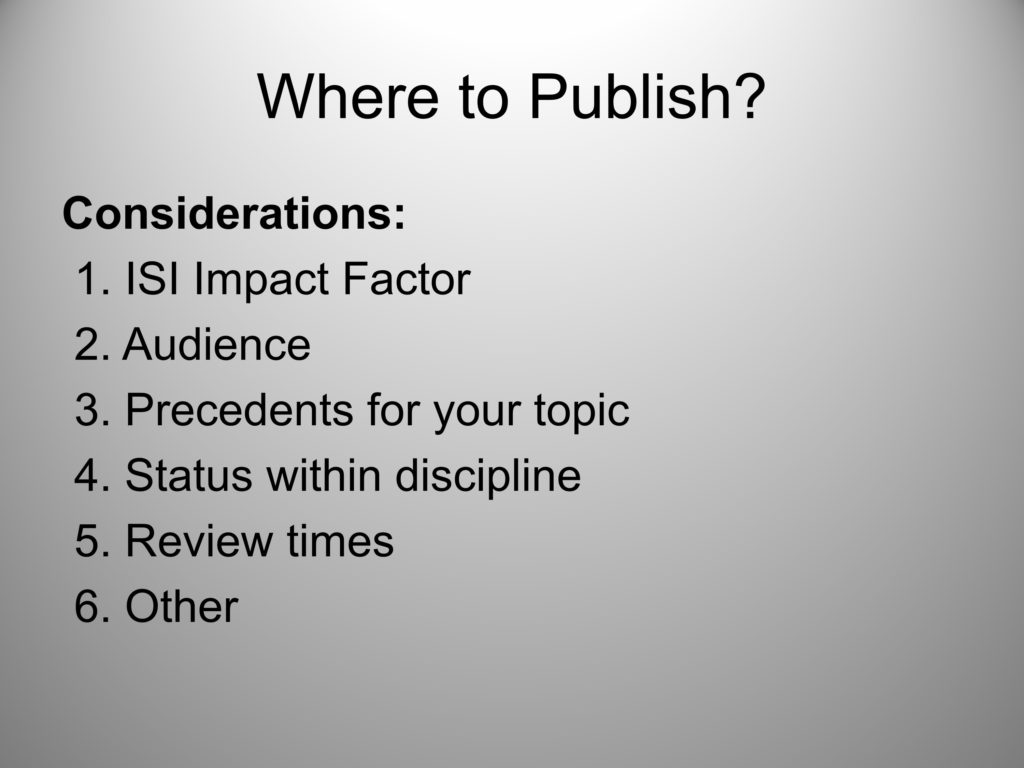 I’m introducing now where to publish. Considerations would include things like the ISI Institute for Scientific information, from Thompson Reuters. The Impact Factor that they have generated, which is widely used. The audience that you want to reach with your publications. The precedents for your topic. Who else published there. The status within the discipline of that particular journal. Review times. And other.
I’m introducing now where to publish. Considerations would include things like the ISI Institute for Scientific information, from Thompson Reuters. The Impact Factor that they have generated, which is widely used. The audience that you want to reach with your publications. The precedents for your topic. Who else published there. The status within the discipline of that particular journal. Review times. And other.
Now what I’m going to do is to have two people who are going to do this point/counter point. And on this one we begin with Dr. Snyde. So I’m all set. I’m Snyde.
“Dr. Snyde”: Think Impact Factor and Only Impact Factor
Think IF and Only IF
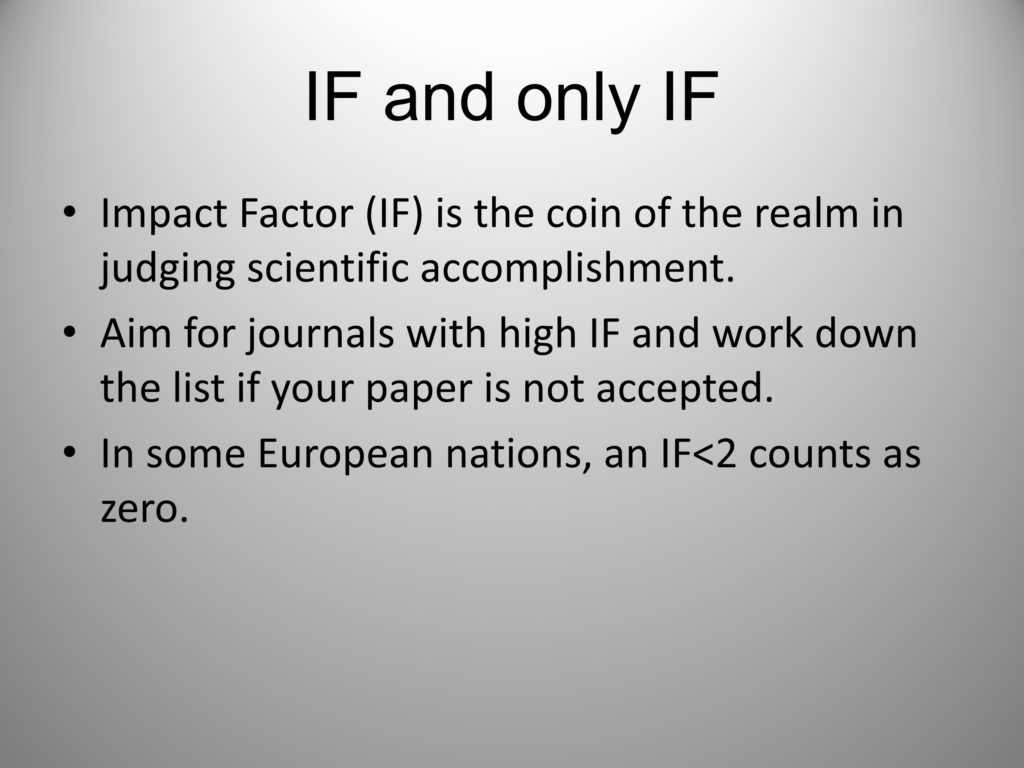
Think IF and only IF. Where I stands for impact and F stands for factor. The Impact Factor is the coin of the realm in judging scientific accomplishment. You want to aim for journals with high Impact Factor and work down the list if your paper isn’t accepted. You want to get attention.
In some European nations, an Impact Factor of less than 2 counts basically as 0. It’s negligible. You may as well self-publish. You might as well put it on your web page.
The Impact Factor Window
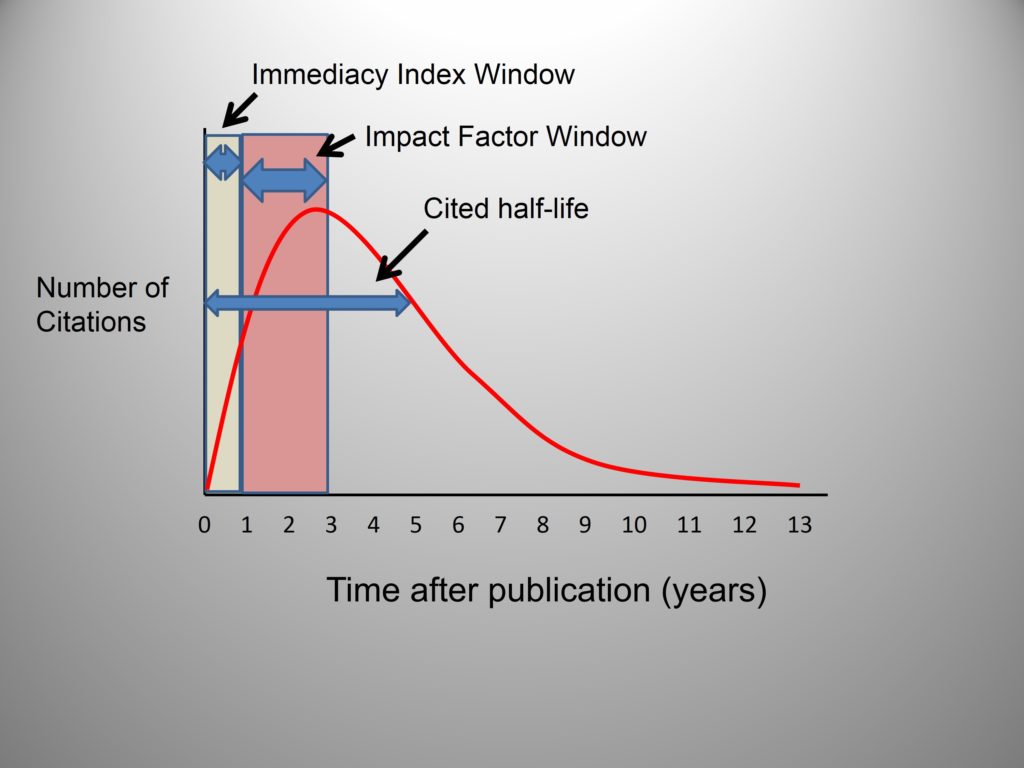 So the Impact Factor is developed by Thompson Reuters. And the primary thing is to know is that Impact Factor window. That’s the two year period, in years 1 to 3, when citations are accumulated. And it’s on that basis that the common Impact Factor is calculated.
So the Impact Factor is developed by Thompson Reuters. And the primary thing is to know is that Impact Factor window. That’s the two year period, in years 1 to 3, when citations are accumulated. And it’s on that basis that the common Impact Factor is calculated.
There are other measures as well, such as the cited half-life. When we publish something, it might be published for a few years following. And the cited half life would be the period in which half of those citations have been reported. Now if you publish a classic paper. You might have a half-life of 15, 20 years. But for many papers, of course, the half-life is vanishingly small. Shortly after they’re published they may not be cited again.
Impact Factor Bulls eye

Now if we look at different Impact Factors — this is kind of a bulls eye. So imagine that you’ve got your bow and arrow. And you’ve got an article that you’re wanting to submit. And you’re going to shoot that arrow. And you’re going to try to get an Impact Factor that’s suitable for you. And you’re thinking of things like tenure and promotion committees. You want to publish in places where they’ll say, “Wow! This journal has a high Impact Factor.” Or if you’re thinking of getting research grants, you know that those reviewers are going to be looking at where you published. And they might say, this journal has a high Impact Factor. Or this has got to be a good scientist, because he or she published in a good place.
Okay. So you can see some of the journals. On off to your left side you can see things like Developmental Psychology. International Journal of Audiology. Brain and Language. Brain. Pediatrics. And then in the middle you see JAMA, Nature, Science. Those all enjoy Impact Factors of the high 20s or low 30s — like 29, 30. So those are kind of the center of the high impact world.
Now if you look at the journals of the American Speech-Language-Hearing Association. And I’m mindful of the building in which I now stand. But notice that they’re out in the orbit of Neptune. So notice that the journals of the American Speech-Language-Hearing Association barely get on the bulls eye. Your arrow is almost off the track entirely if you aim at those journals.
This is Dr. Snyde speaking, and not everybody agrees with me.
Impact Factors for Select CSD Journals
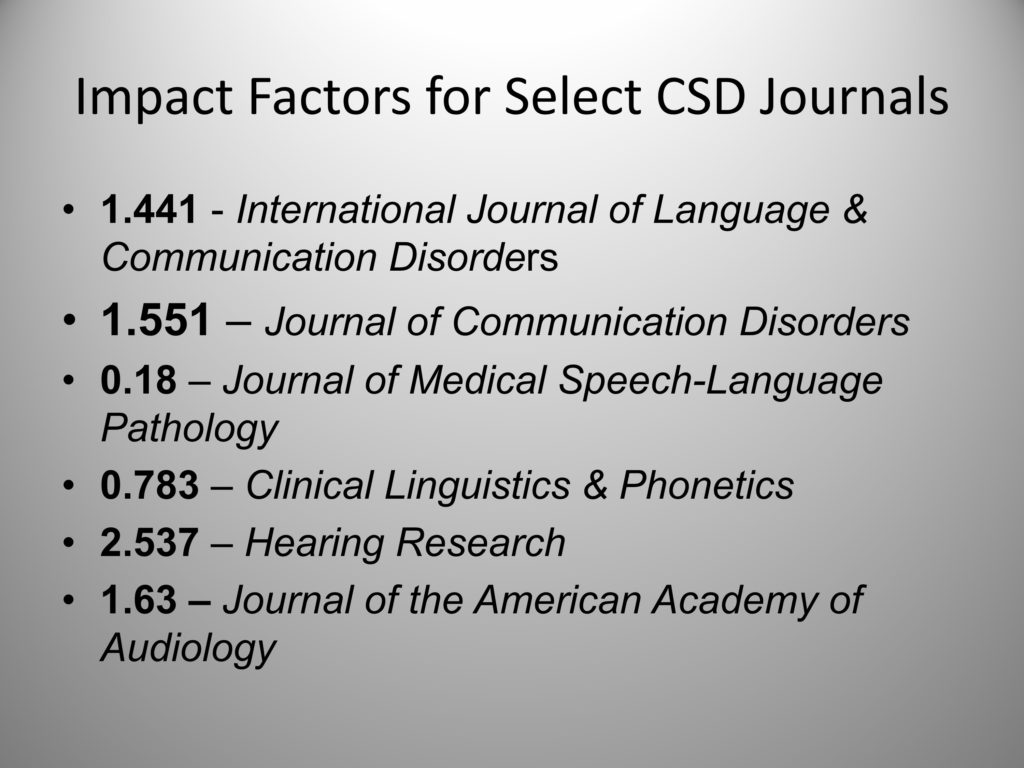
Impact Factors for select CSD journals. These are just a few, and you can look at these at your leisure, but to say that in general they do not have very high impact factors. We’re not talking anything that’s even in the realm of 3 or 4 or 5. We’re talking very low impact factors.
“Professor Heckle”: Let’s Not Worship at the Shrine of the Holy Impact Factor
Some Problems with Impact Factor
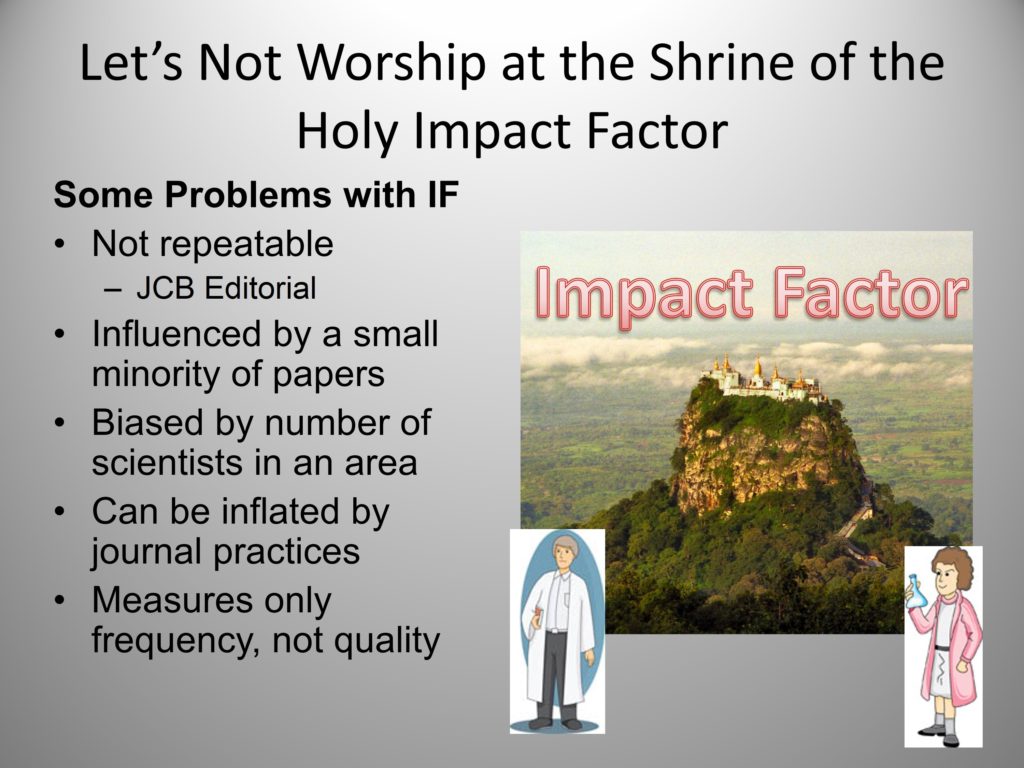
Okay. We’re going to change people. I’m now Professor Heckle — who says, “Dr. Snyde, you’ve been up in the ivory tower of the Impact Factor for far too long. You’re suffering oxygen deprivation. Come on down from that tower, and let’s look seriously at this whole issue of Impact Factor.”
There are some problems with the Impact Factor, and these are becoming more and more clear as time goes on.
First, it’s not repeatable. The Editorial Board of the Journal of Cell Biology did a little experiment in which they tried to replicate the journal Impact Factors reported by Thompson Reuters — ISI. They couldn’t do it. It’s difficult to do this because Thompson Reuters is not exactly free with its database, and said something like, well that’s not the database we use. Or something like that. But the main problem was they found they couldn’t replicate it. Now that’s a big issue for scientists. And yet here we are hanging our scientific careers on a number that may not be replicable.
Furthermore, it’s a number that may not be valid. Because these days the Impact Factor is being used as a gauge of an individual’s research career. It was never intended to be a metric of individual accomplishment. But that’s the way it’s used. And tenure and promotion committees throughout the country are using the Impact Factor as a critical gauge to determine how successful a scientist has been. If you are not up in those higher reaches of the IF, you really haven’t accomplished much at all. And woe to you if you publish in a journal published by the American Speech and Language Hearing Association. Too bad. You probably didn’t even get to a 2 in your Impact Factor.
There are other problems. It can be influenced by small minority of papers. It’s by no means reflective of the great number of papers that are published in a journal. It’s skewed in such a way that a small number of papers are highly influential. It’s based on the number of scientists in an area. So in certain areas where you have a lot of scientists working, you’re going to get a high Impact Factor. But if you’re working in a specialty area where there’s a relatively small community of scientists, your Impact Factor will, of course, be smaller. It has to be because of the way it’s calculated. It’s a mathematical necessity.
It can be inflated by journal practices. If the journal publishes review articles, it will generally get a higher journal IF because review articles tend to be cited more than database articles.
It measures only frequency and not quality. It’s just telling us about number of citations. Frequency, not quality.
JANE: Journal/Author Name Estimator
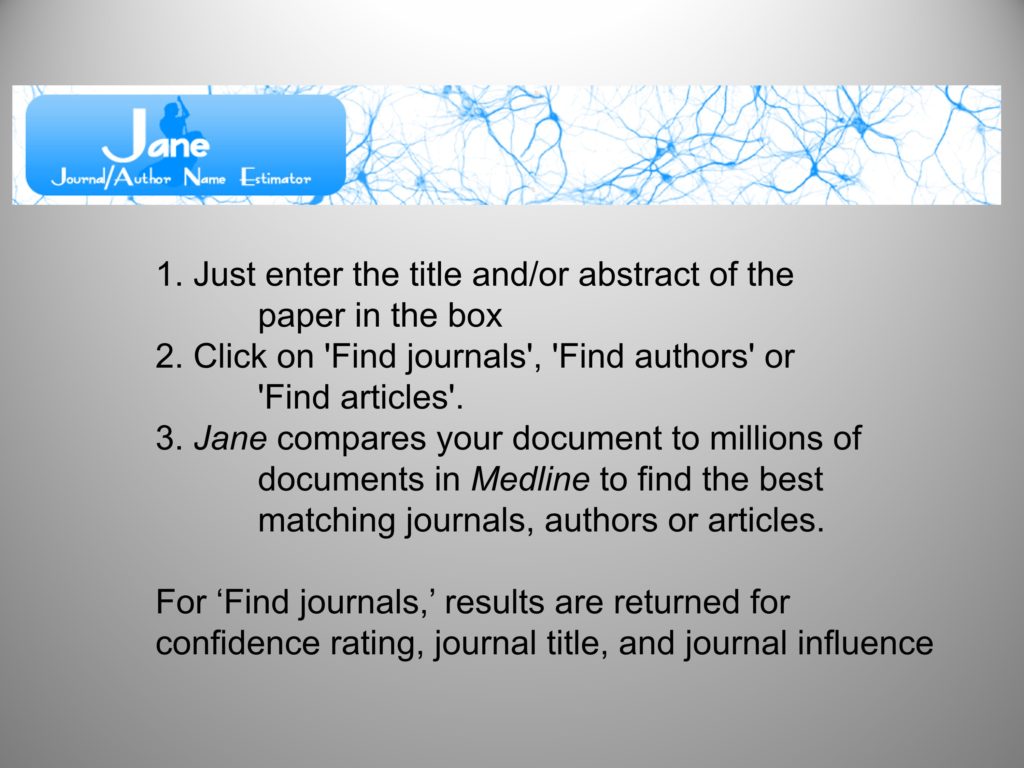 There are other alternatives. For example, if you’ve got a paper. You don’t know where to publish it. But you want to get some sense of where similar work has been published, you can go to something called JANE. Just enter the title or the abstract of the paper in the box. Click on find journals. Or find authors, whatever. And JANE will compare your document to millions of other documents in Medline to find the best matching journals, articles, or titles.
There are other alternatives. For example, if you’ve got a paper. You don’t know where to publish it. But you want to get some sense of where similar work has been published, you can go to something called JANE. Just enter the title or the abstract of the paper in the box. Click on find journals. Or find authors, whatever. And JANE will compare your document to millions of other documents in Medline to find the best matching journals, articles, or titles.
JANE Search Example
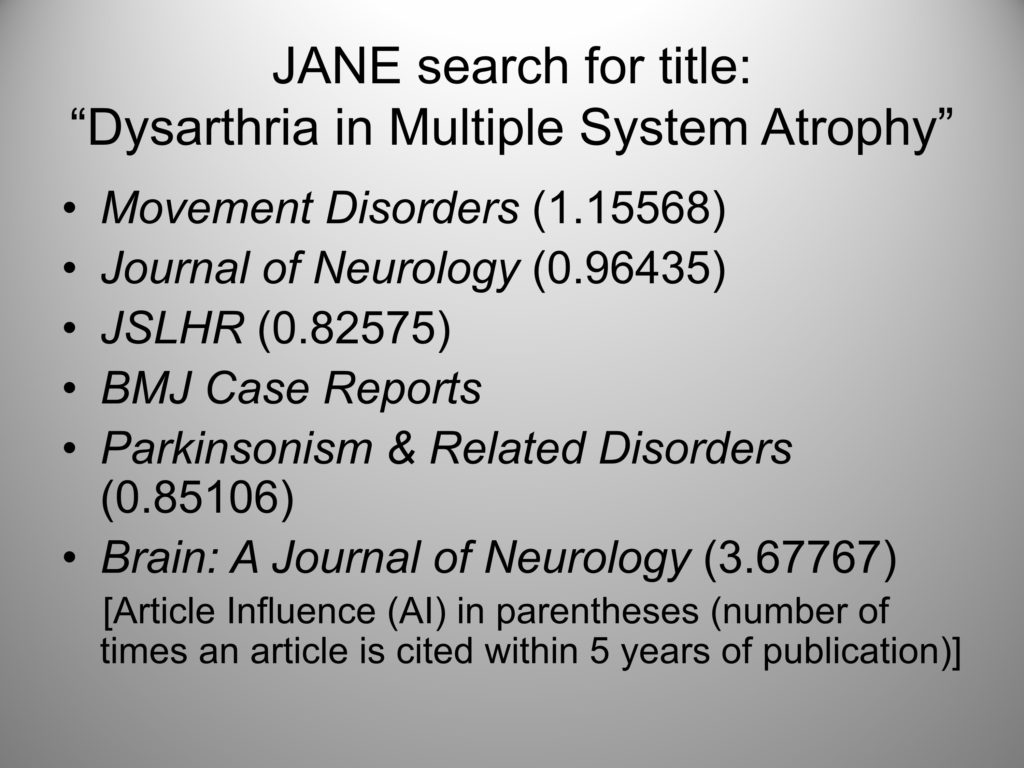 Here’s an example. So I plugged in something that’s not terribly common. Multiple system atrophy. And used this as the topic. And this is what it turned out. These are journals where an article bearing that subject had been published. It included Movement Disorders, Journal of Neurology, JSLHR and so forth. And for each one it gives you the article influence, which is calculated by JANE. It gives you the number of times an article has been cited within five years of publication. So you may say, oh, I’m going to go for the biggie. I’m going to go for Brain, the Journal of Neurology Because that has an article influence of 3.67.
Here’s an example. So I plugged in something that’s not terribly common. Multiple system atrophy. And used this as the topic. And this is what it turned out. These are journals where an article bearing that subject had been published. It included Movement Disorders, Journal of Neurology, JSLHR and so forth. And for each one it gives you the article influence, which is calculated by JANE. It gives you the number of times an article has been cited within five years of publication. So you may say, oh, I’m going to go for the biggie. I’m going to go for Brain, the Journal of Neurology Because that has an article influence of 3.67.
So if you’re wondering where to publish. And you want to reach an audience that has looked at a journal with that topic before — JANE gives you the information. The other thing is, there’s a higher likelihood that these journals are going to have the right reviewers for that article. Because they’ve published in that area before. So they may have access to reviewers who are knowledgeable about that particular area.
SCOPUS Journal Metrics
 You could also look to SCOPUS, which offers Journal Metrics. This is published by Elsevier. And here you can get things like the Source Normalized Impact per Paper. Which measures contextual citation. Impact by weighting citations based on the total number of citations in a subject field.
You could also look to SCOPUS, which offers Journal Metrics. This is published by Elsevier. And here you can get things like the Source Normalized Impact per Paper. Which measures contextual citation. Impact by weighting citations based on the total number of citations in a subject field.
You can get the SCImago Journal Rank, which is a prestige metric. Based on the idea that not all citations are created equal. So there are alternatives. Basic point, Impact Factor is not the only, and maybe not the best way of gauging the quality of a journal. And gauging the quality of an individual investigator.
Not Only IF, Maybe Not IF at All
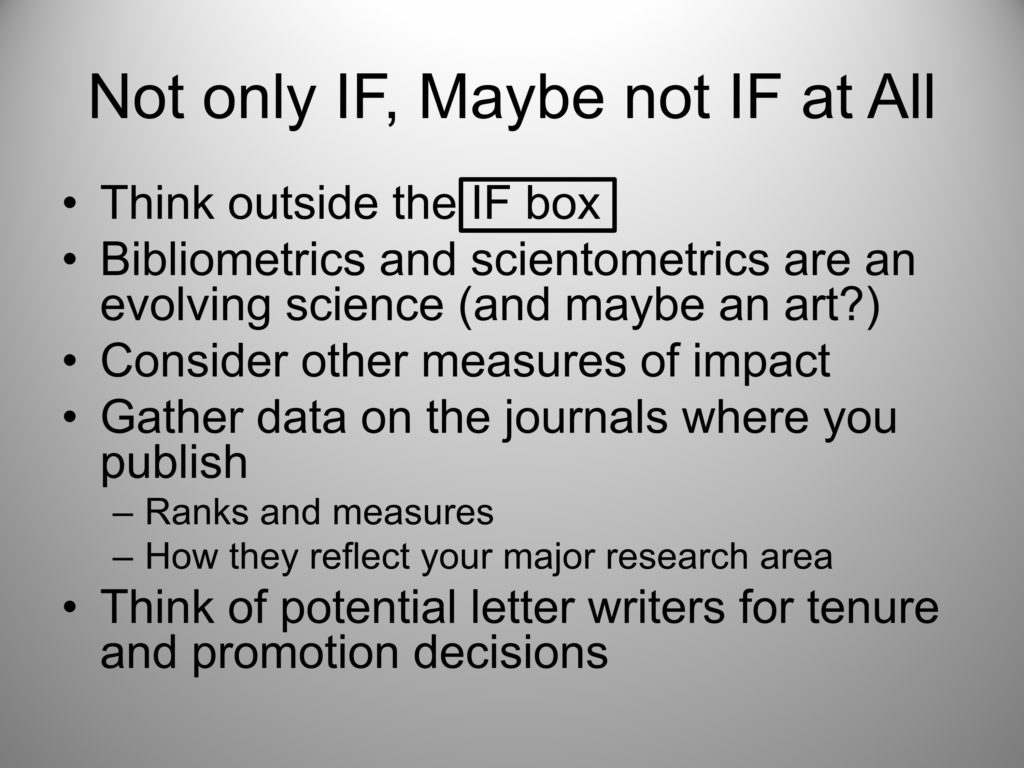 So recommendations coming from Homer Heckle. It’s not only IF — and maybe not IF at all. Think outside the Impact Factor box. Bibliometrics and scientometrics are an evolving science, and there’s a lot of art involved.
So recommendations coming from Homer Heckle. It’s not only IF — and maybe not IF at all. Think outside the Impact Factor box. Bibliometrics and scientometrics are an evolving science, and there’s a lot of art involved.
There is no one metric that is suitable for every purpose. Consider other measures of impact. So when it comes time for you to approach a tenure and promotion committee, don’t just report the Thompson Reuters ISI figures, get data from JANE. Get data from SCImago and other places. Those are very important indices that indicate something about the quality of your work.
The other thing you can do is to gather data on the journals where you publish. Ranks and measures. For example, if you go to the web page for JSLHR, it will tell you how it ranks within certain other major fields. And most of those rankings are quite high. So that’s an important piece to be sure that the tenure and promotion committee and divisional committees recognize that it is in fact a journal that is highly regarded. And you should also make it clear that they reflect your major research area. You publishing there because you want to reach like-minded people. People who are interested in the same, general problems.
Finally, think of potential letter writers for tenure and promotion decisions. Keep them in mind, and it doesn’t hurt to send your work to them. To make sure that they’re aware of what you’re doing. What you’re thinking about is creating the most agreeable environment for you, when it comes time to tenure and promotion. So Professor Heckle says that Dr. Snyde was totally, totally off on this one.





